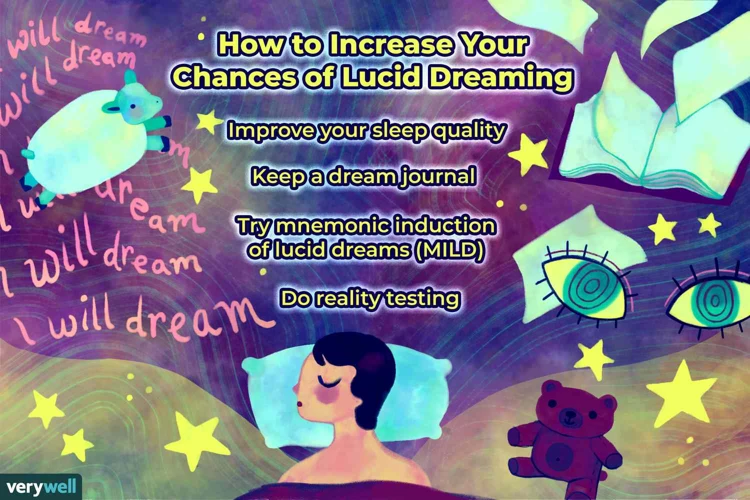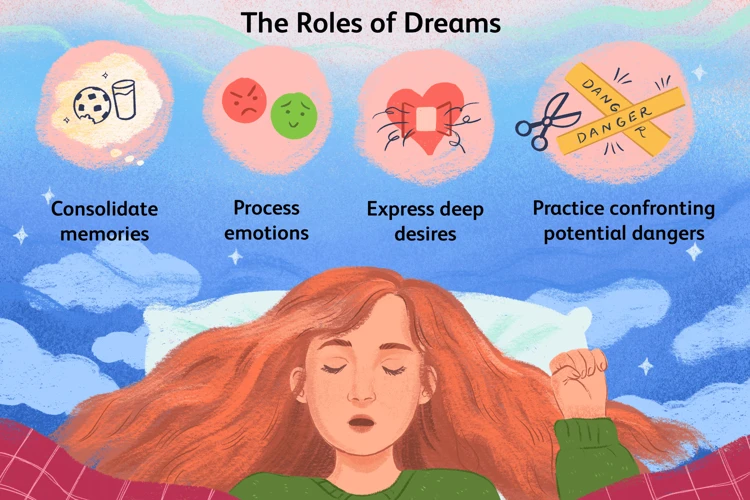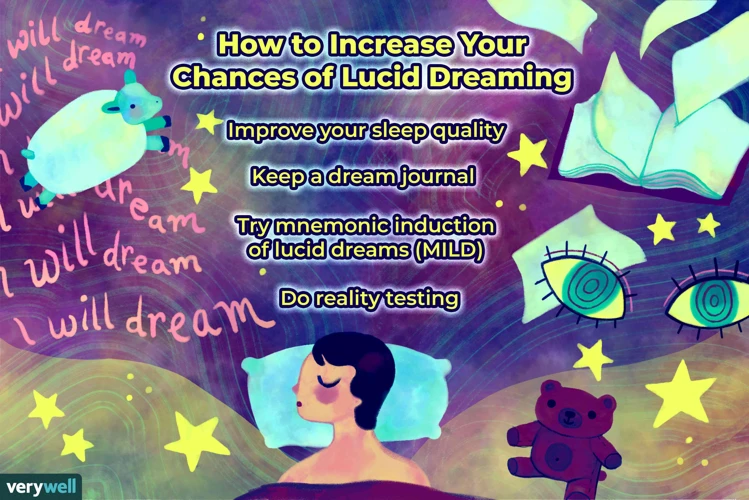Have you ever wondered what it would be like to have complete control over your dreams? To be able to fly through the sky, explore imaginary landscapes, or interact with fictional characters like they were real? Welcome to the intriguing world of lucid dreaming, where the boundaries of reality are blurred, and the possibilities are endless. In this article, we will unravel the secrets of lucid dreaming, diving deep into its definition and understanding its basic principles. We will explore the benefits of lucid dreaming, as well as the step-by-step techniques that can help you achieve this extraordinary state of consciousness. So, get ready to embark on a fascinating journey through the realms of your own mind, as we unlock the secrets of lucid dreaming together.
What is Lucid Dreaming?

Lucid dreaming is a fascinating phenomenon that occurs when a person becomes aware that they are dreaming while still in the midst of the dream itself. Unlike regular dreams where we often passively observe the events unfolding, lucid dreams grant us a unique level of consciousness and control over our dream experience. It’s like being both the director and the star of your own personal movie. In a lucid dream, you can actively engage with the dream environment, manipulate objects and surroundings, and even interact with dream characters. This heightened awareness allows you to fully immerse yourself in a vivid and lifelike dream world that feels remarkably real. Lucid dreaming opens up a realm of endless possibilities, where the laws of physics and limitations of the waking world no longer apply. It’s a playground for the imagination and a gateway to experiences that are bound only by the limits of one’s own mind. To truly grasp the power and potential of lucid dreaming, it’s essential to understand the basics and dive deeper into the mysteries that lie beneath the surface. Is it just a fantastical escapade within the realm of sleep, or does lucid dreaming hold deeper significance and purpose? Let’s explore these questions and unravel the secrets of lucid dreaming.
Understanding the Basics
To understand the basics of lucid dreaming, let’s delve into the fundamental concepts that underpin this extraordinary phenomenon. At its core, lucid dreaming occurs when an individual becomes aware that they are dreaming while still within the dream itself. This realization can come about in various ways, such as noticing incongruities within the dream or performing reality checks that confirm the dream state. Once lucidity is achieved, the dreamer gains the ability to exert control over the dream environment and their actions within it. Lucid dreams can range in intensity and clarity, with some feeling as real as waking life, while others may have a slightly surreal quality. Lucidity can be fleeting, with the dreamer quickly losing awareness and slipping back into a regular nondreaming state or even back into a regular dream. While the specific mechanisms behind lucid dreaming are still not fully understood, several theories suggest that it may be related to the activation of certain brain regions during REM sleep, the stage of sleep where most dreaming occurs. Some individuals may have a natural aptitude for lucid dreaming, while others can learn and develop the skill over time and with practice. The exploration of lucid dreaming goes beyond a simple curiosity; it offers a unique opportunity for self-discovery, personal growth, and even entertainment. Now that we have grasped the basics, let’s delve deeper into the incredible world of lucid dreaming and uncover the amazing benefits and techniques associated with this phenomenon.
Benefits of Lucid Dreaming
Lucid dreaming offers a multitude of benefits that extend beyond mere entertainment and escapism. By actively participating in and manipulating the dream world, individuals can tap into various advantages that can positively impact their waking life. One notable benefit is the opportunity for creative exploration. In a lucid dream, the boundaries of reality are lifted, allowing for unrestricted imagination and the ability to experience things beyond the constraints of the physical world. This can foster creativity and innovation, providing a platform for artists, writers, and innovators to gather inspiration and explore new ideas. Additionally, lucid dreaming can serve as a powerful tool for personal growth and self-discovery. By consciously navigating the dream realm, individuals can confront their fears, overcome obstacles, and gain insight into their subconscious mind. It can be a therapeutic experience, aiding in emotional healing and facilitating self-awareness. Lucid dreaming also allows for enhanced problem-solving abilities, as individuals can, quite literally, dream up solutions to real-life challenges they may be facing. Lucid dreamers can use their dreams as a laboratory for practicing skills and improving performance in various areas of life, from public speaking to sports. The benefits of lucid dreaming are extensive and continue to be explored by researchers and enthusiasts alike. Whether you’re interested in unleashing your creativity, enhancing your personal growth, or simply embarking on exciting adventures in the realm of dreams, the world of lucid dreaming offers a vast array of rewards and possibilities. So, let’s delve deeper into the techniques and methods that can help you achieve lucid dreaming, allowing you to unlock the full potential of this extraordinary experience.
How to Achieve Lucidity

Achieving lucidity in dreams may seem like an elusive endeavor, but with the right techniques and practices, it can become a regular part of your dream repertoire. One of the keys to unlocking lucidity is to develop a habit of performing reality checks throughout the day. These reality checks involve questioning the nature of your reality and testing whether you are dreaming or awake. By incorporating reality checks into your daily routine, such as counting your fingers, trying to push your hand through a solid object, or checking the text on a digital clock, you train your mind to question the boundaries of waking life. Another effective tool for inducing lucid dreams is keeping a dream journal. This practice involves recording your dreams immediately upon waking, capturing as much detail as possible. Dream journals not only improve dream recall but also serve as a tool for recognizing patterns, dream signs, and themes that frequently occur in your dreams. By identifying these recurring elements, you can become more aware of them during your dreams, increasing the likelihood of achieving lucidity. Additionally, various techniques, such as mnemonic induction of lucid dreams (MILD), wake-induced lucid dreams (WILD), and reality testing (RT), can be employed to enhance your chances of experiencing lucidity. Each technique utilizes different approaches, and experimentation is key to finding the one that works best for you. With dedication, practice, and the willingness to explore the depths of your dream world, you can unlock the doorway to lucidity and embark on extraordinary adventures within your own mind. So start incorporating reality checks, keep a dream journal, and delve into the world of lucid dreaming.
Reality Checks and Dream Journals
Reality checks and dream journals are two powerful tools that can help aspiring lucid dreamers increase their chances of achieving lucidity. A reality check is a simple technique that involves questioning your reality throughout the day to determine whether you are awake or dreaming. By regularly performing reality checks, you train your mind to become more aware of your surroundings and to question the validity of your experiences. Some popular reality checks include attempting to push your finger through your hand or trying to read a line of text twice to see if it changes. These reality checks serve as triggers that can carry over into your dream state, prompting you to question the reality of the dream and potentially realize that you are dreaming.
Dream journals, on the other hand, are invaluable for recording and analyzing your dreams. Keeping a dream journal helps you improve your dream recall, making it easier to remember your dreams in greater detail. By writing down your dreams immediately upon waking up, you capture important details, emotions, and themes that may have occurred during the dream. This practice also promotes a deeper connection with your dream world, as you become more attentive and observant of the patterns and symbols that emerge. Dream journaling can uncover hidden meanings and insights into your unconscious mind, offering a gateway to self-discovery and personal growth.
The combination of reality checks and dream journals is a potent strategy for lucid dream induction. By incorporating reality checks into your daily routine and diligently maintaining a dream journal, you train your mind to become more aware and focused on your dreams. Over time, this heightened awareness can carry over into your dream state, increasing the likelihood of encountering situations that trigger lucidity. The habit of recording your dreams in a journal allows you to identify recurring dream signs and themes, which can become cues for lucidity. By analyzing your dream journal, you can identify patterns, symbols, and meaning that may guide your lucid dream exploration. To fully understand the power of dream journals, it’s important to explore the significance of dream interpretation methods (dream interpretation methods) and how they can help decode the messages hidden within our dreams
Inducing Lucid Dreams with Techniques
There are various techniques that can be employed to induce lucid dreams, allowing individuals to experience the realm of conscious dreaming more frequently. One widely practiced method is reality checks. Throughout the day, individuals perform simple actions or observations to determine whether they are in a dream or the waking state. This habit will eventually carry over into their dreams, prompting them to question their reality and trigger lucidity. Another effective technique is maintaining a dream journal. Recording dreams upon waking helps to improve dream recall and identify recurring themes or patterns, serving as a foundation for becoming aware within dreams. Additionally, there are specific induction techniques such as Mnemonic Induction of Lucid Dreams (MILD) and Wake-Induced Lucid Dreams (WILD). MILD involves setting intentions and vividly imagining becoming lucid while falling back asleep, while WILD entails transitioning directly from wakefulness to a lucid dream state through deep relaxation and visualization. Each individual may find certain techniques more effective than others, and it’s essential to experiment and find what works best for them. By incorporating these techniques into their routine, individuals can increase their chances of experiencing the awe-inspiring world of lucid dreaming. Remember, practice and patience are key in unraveling the secrets of lucid dreaming.
Exploring the Lucid Dream Realm

Exploring the lucid dream realm is like embarking on a grand adventure where the only limit is your imagination. Once you have achieved lucidity in a dream, a whole new world opens up before you. One of the most exhilarating aspects of lucid dreaming is the ability to control and shape your dreams. You can fly through the clouds, swim with dolphins in a crystal-clear ocean, or teleport to distant lands, all within the vast expanse of your own mind. With a simple thought or intention, you can conjure up any scenario or environment you desire. Want to visit the ancient ruins of Machu Picchu? Just visualize it, and you’re there. Interested in meeting your favorite historical figure? They can become a tangible presence in your lucid dream. The level of detail and realism in these dreams is astounding, making them feel as vivid and tangible as the waking world. You can heighten your sensory experiences, feeling the warmth of the sun on your skin, tasting the sweetness of a ripe mango, or hearing the gentle rustle of leaves in a forest. The lucid dream realm becomes a canvas upon which you can create and explore to your heart’s content. Another aspect of lucid dreaming that is both fascinating and surreal is the ability to interact with dream characters. These characters may be entirely fictional or representations of people you know in waking life. They can serve as guides, teachers, or even sources of wisdom and insight. Engaging in conversations with dream characters can provide valuable insights into your subconscious mind and offer a fresh perspective on personal challenges or dilemmas you may be facing. You can also choose to ask dream characters for advice, seek their guidance, or simply enjoy their company in this parallel dream universe. The lucid dream realm is a place where anything is possible, where the rules of the waking world no longer hold sway. It is a playground for the creative mind, a sanctuary for exploration and self-discovery. So, what are you waiting for? Step into this extraordinary realm and unlock the wonders that await you within the realm of lucid dreams.
Controlling and Shaping Your Dreams
Controlling and shaping your dreams is one of the most exciting aspects of lucid dreaming. Once you become aware that you are in a dream, a whole new world of possibilities opens up before you. With practice and intention, you can learn to manipulate various elements of your dream environment. It’s like having the power to play “simulator mode” in your own mind. Want to fly through the sky? Simply imagine yourself soaring through the clouds, and your dream will conform to your wishes. Want to explore exotic locations? Close your eyes and envision the destination you desire, and the dream will transport you there. You can even experiment with morphing objects or summoning people or creatures into your dream simply by believing it to be so. It’s important to note that the level of control you have may vary from dream to dream and person to person. Some individuals may find it easier to control certain elements like flying, while others may struggle with more complex manipulations. By practicing visualization, setting clear intentions, and honing your lucid dreaming skills, you can gradually gain more control and shape your dreams in ways that captivate your imagination. So, embrace the limitless potential of lucid dreaming and let your creative powers run wild within the realm of dreams. It’s an extraordinary experience that can inspire and empower you in ways you never thought possible.
Analyzing dreams from a cognitive approach can provide further insights into the mechanics of dream control and how our thought processes influence the dream experience. Understanding the underlying cognitive mechanisms and the symbolism within dreams can enhance your ability to shape and navigate the dream world. Additionally, keeping a dream journal can allow for deeper introspection and help unveil the power of metaphor in dream interpretation. The more you delve into the realms of lucid dreaming, the more you will discover the amazing potential that lies within your own mind.
Interacting with Dream Characters
Interacting with dream characters is one of the most intriguing aspects of lucid dreaming. In this extraordinary state of consciousness, dream characters become more than mere figments of our imagination, and they can take on a life-like quality. These characters can range from friends and family to complete strangers or even mythical creatures. When lucid, we have the unique ability to engage with these dream characters in a meaningful way, opening up avenues for self-discovery and exploration. Some dream characters may offer guidance, wisdom, or insight into our subconscious desires and fears, while others may serve as obstacles or challenges to overcome. Engaging in conversations or interacting physically with dream characters can provide valuable insights and self-reflection upon waking. It can also be a powerful therapeutic tool, as it allows us to confront unresolved emotions or conflicts that manifest within the dream narrative. By actively engaging with dream characters, we can gain a deeper understanding of ourselves and our relationships. It’s important to approach these interactions with an open mind and a willingness to explore the depths of our psyche. Whether it’s seeking advice, confronting fears, or forging connections with our dream counterparts, the possibilities are endless. So, next time you find yourself lucid dreaming, take a moment to interact with the dream characters you encounter. You never know what valuable lessons or profound experiences await you in the realm of dreams. To further delve into the interpretation of dream characters and their significance, you can explore the unveiling power of metaphor in dream interpretation.
Advanced Lucid Dreaming

Advanced lucid dreaming takes the practice of controlling and shaping one’s dreams to a whole new level. Once you have mastered the techniques of inducing lucid dreams and have gained a solid foundation in the basics, you can delve into the realms of advanced lucid dreaming. One aspect of advanced lucid dreaming involves enhancing creativity and problem-solving. In a lucid dream state, the mind is free from the constraints of the waking world, allowing for unlimited possibilities and a heightened state of imagination. Many artists, writers, and inventors have reported tapping into their creative powers within lucid dreams, gaining inspiration for their work and even finding solutions to complex problems. Lucid dreaming can serve as a playground for exploring new ideas, experimenting with different scenarios, and unlocking the depths of one’s own creativity. Additionally, advanced lucid dreaming can be used as a tool for personal growth and self-discovery. By consciously navigating the dream world, individuals can confront their fears, face unresolved conflicts, and gain insights into their own psyche. Lucid dreams can provide a safe space for exploring the subconscious mind and gaining a deeper understanding of oneself. Through journaling and reflecting on the themes and symbols present in lucid dreams, individuals can gain valuable insights into their own thoughts, emotions, and desires. Dream journals become a valuable tool for analyzing patterns and uncovering hidden meanings within the dream realm. By delving into the significance of dream journals and employing interpretation methods, one can unlock the hidden treasures that lie within their own dreams. Advanced lucid dreaming offers a pathway to self-expansion and personal transformation, providing individuals with the opportunity to explore the depths of their own consciousness and tap into their untapped potential.
Enhancing Creativity and Problem Solving
Enhancing creativity and problem-solving abilities are two remarkable benefits that can be derived from the practice of lucid dreaming. When in a lucid dream, the dreamer has the ability to manipulate and shape the dream environment at will, opening up a world where the boundaries of reality can be completely reimagined. This unique creative playground allows individuals to explore new ideas, concepts, and scenarios without the limitations of the waking world. The surreal nature of lucid dreams provides a fertile ground for the generation of innovative and unconventional solutions to real-life problems. Ideas that may seem impossible or illogical in the waking state can suddenly make perfect sense within the context of a lucid dream. By tapping into the vast resources of the subconscious mind, lucid dreaming helps unlock hidden potentials and inspire fresh perspectives. Lucid dreamers can actively experiment with different approaches and test out various scenarios, allowing them to gain insights and understand the potential consequences of their actions. This creative exploration within the dream realm can serve as a powerful tool for personal growth and self-improvement. By honing creativity in lucid dreams, individuals can also enhance their artistic skills, explore new realms of self-expression, and gain a deeper understanding of their own creative processes. Whether you’re an artist, writer, musician, or simply seeking to expand your creativity, lucid dreaming can be a powerful ally in unleashing the full extent of your creative potential. To learn more about the significance of dreams and how dream journals can aid in interpretation and analysis, check out our article on the significance of dream journals and interpretation methods.
Lucid Dreaming for Personal Growth
Lucid dreaming not only offers exciting and immersive experiences but also holds tremendous potential for personal growth and self-development. Through lucid dreaming, individuals can actively engage with their subconscious mind, explore their inner thoughts, and gain valuable insights. One way lucid dreaming facilitates personal growth is by allowing individuals to confront their fears and anxieties in a safe and controlled environment. During a lucid dream, you can consciously face and overcome challenges that may mirror real-life situations, helping you build confidence and resilience. Additionally, lucid dreaming provides a platform for practicing skills and improving performance. Athletes, musicians, and artists can make use of lucid dreams to rehearse techniques, refine their abilities, and enhance their overall performance. The dream state offers a unique opportunity for exploration and experimentation, enabling individuals to push the boundaries of their creativity and imagination. Lucid dreaming can also be utilized as a means of self-reflection and problem-solving. By entering a lucid dream with a specific question or issue in mind, you can tap into your subconscious wisdom and gain fresh perspectives and solutions. To harness the power of lucid dreaming for personal growth, it is essential to cultivate self-awareness and set intentions before going to sleep. This can be achieved through mindfulness practices, affirmations, and visualizations. By actively seeking personal growth within the lucid dream state, individuals can unlock deeper aspects of themselves, expand their consciousness, and embark on a journey of self-discovery.
Scientific Insights and Studies

Scientific research has delved into the fascinating realm of lucid dreaming, providing valuable insights into this mysterious phenomenon. The field of neuroscience has been instrumental in unraveling the mechanisms behind lucid dreaming. Studies using electroencephalography (EEG) have revealed distinct brainwave patterns associated with lucidity during sleep, such as increased activity in the frontal cortex. These findings suggest that lucid dreaming involves a unique state of consciousness that differs from both waking and non-lucid dreaming states. Research has explored the potential applications of lucid dreaming in various fields. For example, studies have investigated the use of lucid dreaming in enhancing problem-solving skills and promoting creativity. Lucid dreaming may offer a platform for experimenting with new ideas, visualizing solutions, and overcoming mental blocks. Advancements in technology have facilitated the exploration of lucid dreaming. Devices such as lucid dreaming masks, which detect rapid eye movement (REM) sleep and provide sensory cues, have been developed to assist individuals in inducing and maintaining lucidity during dreams. These technological innovations have opened up new avenues for studying and experiencing lucid dreams in a controlled manner. As research continues to unravel the scientific underpinnings of lucid dreaming, new discoveries are being made that shed light on the nature of consciousness and the untapped potential of the human mind.
The Neuroscience of Lucid Dreaming
The neuroscience of lucid dreaming is a rapidly growing field of research that seeks to uncover the underlying brain mechanisms and processes that occur during these unique dream states. Studies have shown that lucid dreaming involves a complex interplay of various brain regions and neurotransmitters. One key area of interest is the prefrontal cortex, which plays a crucial role in self-awareness, decision-making, and higher cognitive functions. During lucid dreaming, the prefrontal cortex becomes highly active, indicating a heightened level of consciousness and metacognitive abilities. Additionally, researchers have found increased activity in the parietal cortex, which is responsible for spatial awareness and sense of self. This suggests that lucid dreamers have a greater sense of agency and control within their dreams. Neurotransmitters such as acetylcholine and serotonin also play a significant role in lucid dreaming. Studies have shown that levels of acetylcholine, which is associated with wakefulness and attention, are elevated during the REM (rapid eye movement) sleep stage, where most dreams occur. This may contribute to the increased self-awareness and cognitive abilities observed in lucid dreaming. Serotonin, on the other hand, is believed to inhibit rapid eye movement and may play a role in maintaining normal dreaming states, making it a potential target for inducing lucid dreams. Understanding the neuroscience of lucid dreaming allows us to gain insights into the brain’s intricate workings during altered states of consciousness. It paves the way for further research on the potential therapeutic applications of lucid dreaming and its implications for understanding the nature of consciousness itself.
Exploring Lucid Dreaming with Technology
Exploring lucid dreaming with technology has opened up exciting possibilities for dream enthusiasts. Researchers and inventors have developed various tools and devices to aid in the induction and enhancement of lucid dreams. One such technology is the lucid dreaming mask, also known as a dream mask or REM sleep mask. This device is worn during sleep and uses sensors to detect Rapid Eye Movement (REM) sleep, which is associated with dreaming. When the mask senses REM sleep, it delivers subtle cues, such as flashing lights or vibrations, to prompt the dreamer to become aware they are dreaming. This can be a helpful aid for those who are actively trying to achieve lucidity in their dreams. Another technological advancement that aids in exploring lucid dreaming is the use of smartphone apps and wearable devices. These apps often include features like reality check reminders, dream journals, and guided meditation or hypnosis sessions specifically tailored for lucid dreaming induction. Wearable devices, such as wristbands, can be worn during sleep to track sleep patterns and provide real-time data that can help users identify their optimal times for lucid dream induction. Some advanced devices even claim to stimulate the brain during sleep using methods like electrical or magnetic stimulation to increase the likelihood of lucid dreaming. While technology can be a valuable tool for those interested in exploring lucid dreaming, it’s important to remember that it is not a magic solution. The true power lies within our consciousness and intention to explore the depths of our dream world. Technology can simply serve as a facilitator and enhance our journey. So, whether you choose to use technology or rely on more traditional methods, embracing the wonders of lucid dreaming is an adventure that can lead to unparalleled experiences and self-discovery.
Common Challenges and How to Overcome Them
Common Challenges and How to Overcome Them
1. Maintaining Lucidity during Dreams:
One of the main challenges in lucid dreaming is maintaining awareness and control once you become lucid. It is common for beginners to get too excited upon realizing they are in a dream, which can quickly lead to a loss of lucidity and a return to a regular dream state. To overcome this challenge, practice staying calm and focused when you become lucid. Take a moment to ground yourself by engaging your senses – touch a nearby object, feel the texture, and observe the details. Remind yourself that you are in control and that the dream world is yours to explore.
2. Dealing with Nightmares and Sleep Paralysis:
While lucid dreaming can be a thrilling experience, it can also bring about intense emotions and even nightmares. Nightmares can be particularly distressing when you are aware that you are dreaming but struggle to wake up. One effective technique to overcome nightmares is to confront the source of fear head-on. Remember that you have the power to change the dream narrative and transform the frightening elements into something more positive. Another challenge that some people face during the transition into lucid dreaming is sleep paralysis, which occurs when the body is temporarily unable to move upon waking up or falling asleep. To overcome sleep paralysis, try to remain calm and focus on wiggling your fingers or toes, which can help regain control of your body. It’s also helpful to establish a regular sleep schedule and maintain good sleep hygiene to minimize the likelihood of experiencing sleep paralysis.
By understanding and consciously working through these common challenges, you can enhance your lucid dreaming journey and unlock the full potential of this extraordinary state of consciousness. Don’t let these obstacles discourage you – instead, view them as opportunities for growth and exploration within the dream realm.
Maintaining Lucidity during Dreams
Maintaining lucidity during dreams can be a challenge as the dream state tends to be fluid and unpredictable. However, there are certain techniques and strategies that can help you stay aware and in control throughout your lucid dreaming experience. One of the key factors in maintaining lucidity is maintaining a strong sense of self-awareness. It’s important to continuously remind yourself that you are in a dream and not get caught up in the storyline or events unfolding in the dream. This can be achieved through regular reality checks, which involve questioning the nature of your reality throughout the day. These reality checks can then become a habit that carries over into your dreams, helping you recognize when you are in a dream state. Another useful technique is the use of anchors or “dream signs” within the dream itself. These are elements or occurrences that are unique to your dreams and can serve as triggers for lucidity. For example, if you often dream of flying, seeing yourself in a flying situation in a dream could serve as a cue for you to become lucid. Additionally, practicing meditation and mindfulness in your waking life can also enhance your ability to maintain lucidity during dreams. These practices cultivate a sense of presence and focus that can carry over into your dream state. By staying present and aware, you can avoid getting caught up in the dream narrative and fully embrace your lucid dream experience. So, whether it’s through reality checks, dream signs, or mindfulness techniques, finding the methods that work best for you will greatly aid in maintaining lucidity and maximizing the potential of your lucid dreams.
Dealing with Nightmares and Sleep Paralysis
Dealing with nightmares and sleep paralysis can be a daunting aspect of lucid dreaming, but understanding how to navigate these challenges can help you make the most of your experiences. Nightmares during lucid dreams can be particularly intense due to the heightened level of awareness. If you find yourself in the midst of a nightmarish scenario, remember that you have the power to take control. One effective technique is to confront the source of fear head-on. By facing your fears, you can regain control and transform the nightmare into something more positive. Another approach is to call upon your creative abilities and reshape the dream environment into a more pleasant setting. For instance, imagine yourself surrounded by a calming and peaceful landscape or summon a friendly guide to accompany you. Sleep paralysis, on the other hand, occurs when you wake up from a dream but find that your body remains immobile. This can be a distressing experience, as it may feel as though you are trapped or unable to move. To overcome sleep paralysis, try focusing on small movements, such as wiggling your toes or fingers. This can help signal your body to fully awaken. Remaining calm and reminding yourself that it is a temporary state can also alleviate anxiety. Establishing a regular sleep routine, practicing relaxation techniques, and creating a comfortable sleep environment can help reduce the frequency of sleep paralysis episodes. As with any challenges in lucid dreaming, patience, practice, and a positive mindset are key to overcoming nightmares and sleep paralysis and enjoying the incredible realm of lucid dreaming to its fullest potential.
Conclusion
In conclusion, lucid dreaming is a fascinating and powerful phenomenon that allows us to explore the depths of our own consciousness and unleash our imaginative potential. Through various techniques and practices, we can enhance our ability to become lucid within our dreams, enabling us to take control and shape the dream experience to our liking. Lucid dreaming offers numerous benefits, including increased self-awareness, personal growth, problem-solving abilities, and even enhanced creativity. Scientific studies have shed light on the neuroscience behind lucid dreaming, revealing the unique brain patterns and processes that occur during this state. Moreover, advancements in technology have opened up new avenues for exploring and studying lucid dreaming. Despite the challenges and occasional setbacks that may arise, such as maintaining lucidity or dealing with nightmares and sleep paralysis, the rewards of lucid dreaming are well worth the effort. It presents us with a profound opportunity to unlock the hidden depths of our subconscious mind, tap into our limitless imagination, and embark on incredible adventures within the dream realm. So, why wait? Start on your own journey of unraveling the secrets of lucid dreaming and embark on an extraordinary exploration of the mind.
Frequently Asked Questions
What are reality checks and how do they help with lucid dreaming?
Reality checks are techniques used to determine whether you are awake or dreaming. By performing simple actions, such as looking at your hands, trying to push your finger through your palm, or questioning your surroundings throughout the day, you can train your mind to question reality. This practice can carry over into your dreams, increasing the chances of becoming lucid when you notice inconsistencies or impossibilities.
Why is keeping a dream journal important for lucid dreaming?
Keeping a dream journal is vital for lucid dreamers. By writing down your dreams as soon as you wake up, you strengthen your dream recall abilities. This increased awareness of your dream experiences can help you identify dream patterns, recurring themes, or dream signs. These valuable insights can serve as triggers for lucidity, helping you recognize when you are in a dream state.
What are some effective techniques for inducing lucid dreams?
There are several techniques you can try to induce lucid dreams. Some popular methods include reality testing, mnemonic induction of lucid dreams (MILD), wake-induced lucid dreaming (WILD), and the use of lucid dreaming supplements like Galantamine or Choline. Experimenting with different techniques can help you find what works best for you.
How can you control and shape your dreams during lucid dreaming?
Once you achieve lucidity in a dream, there are various ways to control and shape your dream experience. You can practice flying, teleportation, or morphing the dream environment to your desires. By using visualization and intention, combined with a strong belief in your ability to manipulate the dream, you can transform the dream world according to your imagination.
Can you interact with dream characters in lucid dreams?
Yes, you can interact with dream characters in lucid dreams. Dream characters can be as vivid and lifelike as the dream itself. You can engage in conversations, ask them questions, seek guidance or simply observe their behavior. Some lucid dreamers even use dream characters as a means of gaining deeper insights into their own thoughts and subconscious mind.
How can lucid dreaming enhance creativity and problem-solving abilities?
Lucid dreaming can serve as a powerful tool for enhancing creativity and problem-solving. In a lucid dream, you can explore new ideas, experiment with innovative solutions, and push the boundaries of your imagination. By practicing specific techniques, such as dream incubation or seeking inspiration from dream symbols, you can tap into the limitless creative potential of the dream world.
Is lucid dreaming beneficial for personal growth?
Absolutely! Lucid dreaming can be a powerful catalyst for personal growth and self-discovery. It offers a unique platform for exploring unresolved emotions, fears, and desires. Lucid dreams can provide opportunities for confronting and overcoming personal obstacles, practicing new skills, or even rehearsing challenging situations in a safe and controlled environment.
What does neuroscience tell us about lucid dreaming?
Neuroscience research has shed light on the fascinating nature of lucid dreaming. Studies suggest that lucid dreaming involves increased activity in the prefrontal cortex, the part of the brain responsible for self-awareness and decision-making. Neuroscientific findings have also revealed similarities between the brain activity during lucid dreaming and waking consciousness, further emphasizing the unique state of awareness experienced in lucid dreams.
Can technology be used to explore and enhance lucid dreaming?
Yes, technology can be used to explore and enhance lucid dreaming experiences. Techniques such as lucid dreaming masks, which detect rapid eye movement (REM) sleep and provide visual or auditory cues to prompt lucidity, have shown promising results. Additionally, virtual reality (VR) and brainwave entrainment devices have been utilized to create immersive dream environments and induce lucid dreaming states.
How can one deal with nightmares and sleep paralysis during lucid dreaming?
Nightmares and sleep paralysis can sometimes occur during lucid dreaming or upon awakening from a lucid dream. To deal with nightmares, techniques such as confronting and transforming the threatening aspects of the dream, or utilizing relaxation and visualization exercises, can be effective. Regarding sleep paralysis, maintaining a calm mindset and focusing on small movements, such as wiggling your fingers or toes, can help break free from the immobilized state.








